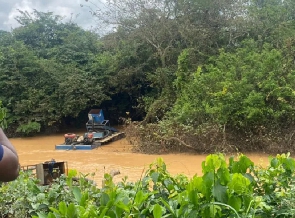 Galamsey activities on waterbodies
Galamsey activities on waterbodies
The Managing Director of Ghana Water Company Limited (GWCL), Mr. Clifford Braimah, has disclosed that about 50 percent of water treated by the company is wasted due to the impact of illegal mining activities, popularly known as galamsey. He said, for instance, that in the years gone by only five percent of the treated water was wasted, but currently out of 100 litres produced about 50 percent of it is waste owing to turbidity of the water. “Out of 100 litres of water treated, under normal circumstances we should throw away 5 percent. But because of the high level of turbidity, in some of the cases we throw up to 50 percent away,” he narrated. According to the MD of GWCL, the situation has led to rationing water in some communities – adding that the toll of galamsey on their operations is devastating. The company, Mr. Braimah added, now spends a huge sum of money on almost all its plants to treat water for consumption owing to illegal mining activities. The water turbidity, which he attributed to galamsey activities, cuts across waterways in the country. This causes the company to spend so much on very expensive chemicals for treatment. Also, he noted, the causes of pollution have resulted in a drastic reduction of water supplyvolume. Mr. Braimah was speaking in an interview at the backdrop of a tour the Minister of Sanitation and Water Resources, Cecilia Abena Dapaah, made to the Ashanti Region, and said the only place that has clean water to treat is Kpone. This, he said, is because the Volta River has still not been disturbed that much; and also the fact that the water undergoes various stages of segmentation before reaching Kpone. He said owing to galamsey activities which have caused significant pollution of water-bodies, the machines used for treatment are periodically stopped and maintained more regularly than before. This is causing shutdowns to become more frequent, he added. “Anytime you shut down your plant it means the people are not getting water, and so the causes are multiple. We cannot continue to operate this way, or else we will all have a challenge in this country,” he said. The Minister of Sanitation and Water Resources, Cecilia Abena Dapaah – addressing an open forum at a stop at Bedabour in the Atwima Mponua District of the Ashanti Region, expressed worry about the state of water-bodies in Ghana. She noted that this development has rendered many water-bodies unusable, with aquatic life becoming rare in water-bodies across the country. The minister reminded residents of the Bedabour community that chemicals used in mining, such as mercury and cyanide are deadly – and can cause problems for women and their unborn babies. She rallied the community to help government overcome the galamsey menace while calling for a collaborative effort to help arrest and prosecute illegal miners.
The Managing Director of Ghana Water Company Limited (GWCL), Mr. Clifford Braimah, has disclosed that about 50 percent of water treated by the company is wasted due to the impact of illegal mining activities, popularly known as galamsey. He said, for instance, that in the years gone by only five percent of the treated water was wasted, but currently out of 100 litres produced about 50 percent of it is waste owing to turbidity of the water. “Out of 100 litres of water treated, under normal circumstances we should throw away 5 percent. But because of the high level of turbidity, in some of the cases we throw up to 50 percent away,” he narrated. According to the MD of GWCL, the situation has led to rationing water in some communities – adding that the toll of galamsey on their operations is devastating. The company, Mr. Braimah added, now spends a huge sum of money on almost all its plants to treat water for consumption owing to illegal mining activities. The water turbidity, which he attributed to galamsey activities, cuts across waterways in the country. This causes the company to spend so much on very expensive chemicals for treatment. Also, he noted, the causes of pollution have resulted in a drastic reduction of water supplyvolume. Mr. Braimah was speaking in an interview at the backdrop of a tour the Minister of Sanitation and Water Resources, Cecilia Abena Dapaah, made to the Ashanti Region, and said the only place that has clean water to treat is Kpone. This, he said, is because the Volta River has still not been disturbed that much; and also the fact that the water undergoes various stages of segmentation before reaching Kpone. He said owing to galamsey activities which have caused significant pollution of water-bodies, the machines used for treatment are periodically stopped and maintained more regularly than before. This is causing shutdowns to become more frequent, he added. “Anytime you shut down your plant it means the people are not getting water, and so the causes are multiple. We cannot continue to operate this way, or else we will all have a challenge in this country,” he said. The Minister of Sanitation and Water Resources, Cecilia Abena Dapaah – addressing an open forum at a stop at Bedabour in the Atwima Mponua District of the Ashanti Region, expressed worry about the state of water-bodies in Ghana. She noted that this development has rendered many water-bodies unusable, with aquatic life becoming rare in water-bodies across the country. The minister reminded residents of the Bedabour community that chemicals used in mining, such as mercury and cyanide are deadly – and can cause problems for women and their unborn babies. She rallied the community to help government overcome the galamsey menace while calling for a collaborative effort to help arrest and prosecute illegal miners.